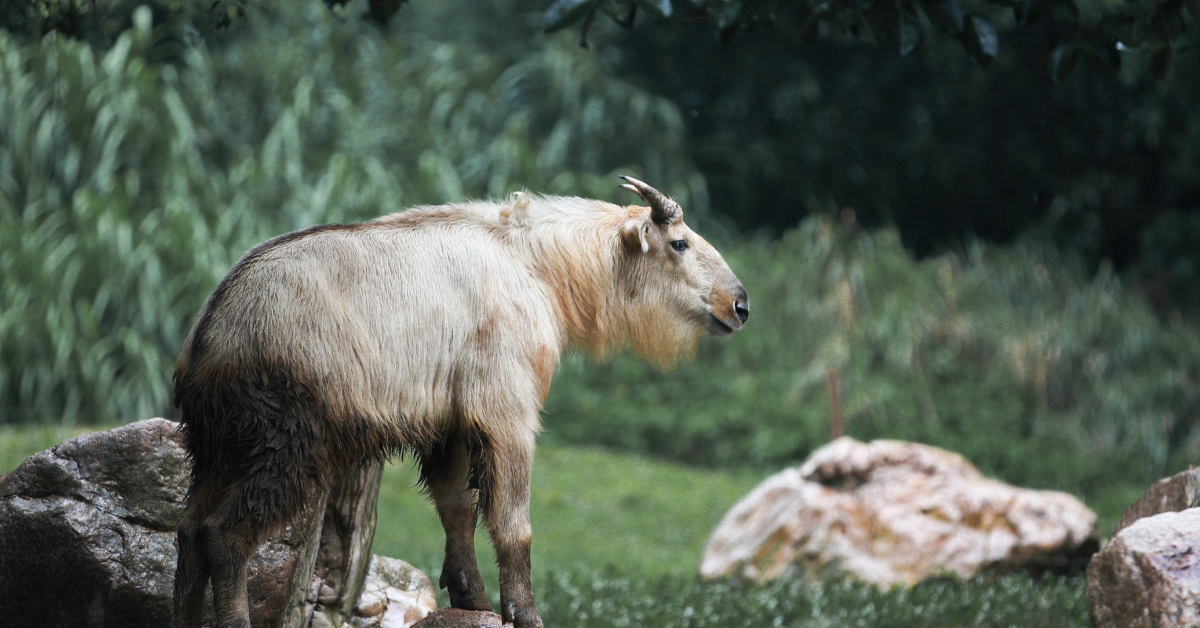The Sichuan takin, also known as the Tibetan takin (Budorcas taxicolor tibetana), is the most prominent and widely distributed subspecies of takin (goat-antelope) found in the People’s Republic of China.
It is listed as a “vulnerable” species by the IUCN Red List due to poaching and habitat destruction. However, last year a group of scientists published a paper in the Ecology and Evolution journal, suggesting that according to their assessment, this species is more endangered than what the IUCN Red List “vulnerable” category portrays.
First, what is a Sichuan Takin?
Get to know the animal in question.

What type of animal is a takin?
A takin, also known as Budorcase tibetanus, is a species of asian ungulate that is not commonly found. Ungulates are mammals with hooves or toenails that are modified for support and movement, and are commonly referred to as “hoofed animals.” They are herbivorous and can be found in a variety of habitats, including grasslands, forests, deserts, and mountains. Examples of more common ungulates include deer, antelope, cattle, horses, zebras, giraffes, and many others.
Geographic range:
Their habitat is mainly limited to the Sichuan Province of China, although small areas of their distribution extend into Gansu Province.
Physical appearance:
The Sichuan takin is a large animal, standing its height ranges from 3.3-4.5ft and can weigh as much as 770 pounds.
They possess fluffy coats with colors ranging from dark brown to blonde, and their snout is always black. Their shiny black horns can grow up to 60cm (35in) long. They have split hooves that make them sure-footed even on treacherous cliffs and lack skin glands. Lastly, they develop a thicker coat in winter for insulation from the cold.
Diet:
The takin feeds on a variety of vegetation including herbs, bamboo leaves, pine and willow bark, oak, and evergreen rhododendrons. It can reach vegetation by standing on its hind legs and propping its legs up on a tree. The takin can also use its powerful body to push over small trees and get his food!
Behavior:
Sichuan takins live in herds of up to 300 individuals and climb up steep mountains to reach vegetation during summer. In late summer’s rutting (mating) season, older bulls are usually solitary.
During cooler seasons when food becomes limited, smaller groups of 10 to 35 go down to feed in forests valleys. In early spring, cows give birth to one kid after a gestation period of seven or eight months.
When facing danger, takins emit a roar or bellow to intimidate their foes. They warn other herd members of danger by producing a coughing sound. Other than bears and wolves, they have few natural predators.
Is the Sichuan Takin endangered?: What the scientists say

While the IUCN Red List of Threatned Species is the primary applied reference for biodiversity conservation, limitations in data availability and analysis of the distributions of some species may limit accurate threat classification assesments and conservation recommendations.”
Tianpei, G., Owens, J. R., Kong, Y., Jian, Y., Xiaodong, G., & Yanling, S. (2022). The need for IUCN species distribution update—The case from takin (Budorcas taxicolor) in Southwest China. Ecology and Evolution, 12, e9222. https://doi.org/10.1002/ece3.9222
In the study “The need for IUCN species distribution update—The case from takin (Budorcas taxicolor) in Southwest China“, published in 2022, Tianpei et al reassessed the geographical range of the Sichuan takin, using species distribution models and habitat requirements. They then updated the map of the takin’s geographical range and found out that their updated range in the study area (79,449 km2) was 38.69% less than the current range published on the IUCN Red List.
Because of said discrepancy, an update of their geographic distribution is key. After overlapping the range provided by their results with the polygon published in the IUCN Red List, the scientists created the updated map of the takin distribution (shown here).
Conclusion
As a conclusion, Tianpei et al sustained that the Sichuan Takin was endangered beyond vulnerable and gave the scientific basis behind their stance. They also provided recommendations for further assessments. You can read it here.
It’s important to have the correct knowledge behind every species conservation status, but it’s also important to remember that the IUCN Red List has limited resources and cannot be assessing every single species every year. It is findings like these that help them in their honest labor. It is up to us to bring them to the spotlight!
If you liked this post, you may also like the first episode of our new series “Endangered Species” featuring the Orinoco crocodile, check it out!


2 responses to “The Sichuan Takin: more endangered than IUCN Red List suggests”
[…] Bubalus mindorensis (scientific name of the Tamaraw) is a large ungulate. As we explained in a past post about the Sichuan Takin’s endangered status, ungulates are mammals with hooves or toenails that are modified for support and movement. People […]
[…] Secondly, you might want to read the blog post about the Sichuan Takin and find out why he is endangered and not just “vulnerable”, click here. […]